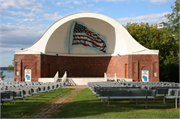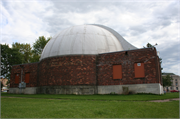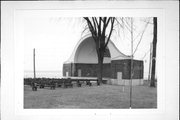Property Record
MEMORIAL PARK, LAKE SHORE DR W BETWEEN ELLIS AND 2ND AVE W
Architecture and History Inventory
| Historic Name: | MEMORIAL PARK BANDSHELL |
|---|---|
| Other Name: | MEMORIAL PARK BANDSHELL |
| Contributing: | |
| Reference Number: | 681 |
| Location (Address): | MEMORIAL PARK, LAKE SHORE DR W BETWEEN ELLIS AND 2ND AVE W |
|---|---|
| County: | Ashland |
| City: | Ashland |
| Township/Village: | |
| Unincorporated Community: | |
| Town: | |
| Range: | |
| Direction: | |
| Section: | |
| Quarter Section: | |
| Quarter/Quarter Section: |
| Year Built: | 1934 |
|---|---|
| Additions: | |
| Survey Date: | 19822016 |
| Historic Use: | bandstand |
| Architectural Style: | Colonial Revival/Georgian Revival |
| Structural System: | |
| Wall Material: | Brick |
| Architect: | THOMAS SHEFCHIK |
| Other Buildings On Site: | |
| Demolished?: | No |
| Demolished Date: |
| National/State Register Listing Name: | Not listed |
|---|---|
| National Register Listing Date: | |
| State Register Listing Date: |
| Additional Information: | 1982: Symmetrical red brick band shell with neo-classical entry details of a Georgian Revival character. Arched doorways in each end pavillion with pedimental motifs above. Large American flag painted in shells center is part of original design. (15: View from NE of Memorial Park and E. Front Street (renamed Lake Shore Drive) 1982: The bandshell is historically significant for its association with Ashland's park system development. The building was conceived in the early 1930's when a Milwaukee landscape architect, Phelps Wyman, drew up plans for the Bay Front and Prentice Park system. Ashland architect, Thomas Shefchik, drew up the original plans and the project was commenced with funds from the CWA. Soon thereafter the funds were cut off. Rather than terminating the project, Mayor John M. Dodd organized a fund drive to complete the shell, which was first used on July 4, 1934, and dedicated later. The ceremony included the American Legion drum corps performance and speeches by Mayor Dodd, Crague Bigelow of the band committee and Frank S. Dhooge of the Park Board. The band shell is significant, too, for it is apparently the only structure in Ashland related to the CWA which only partially funded the project. The flag was painted by the Knights of Pythias and the shell is still used today during warm months. 2017 report information: Located in Memorial Park , this structure features a curved, concrete shell over a red brick base. The concrete deck is flanked by two entry pavilions (the doors of which have been removed) with modest brickwork detailing. The brick of the walls are laid in common bond, with every sixth row being comprised of headers. Four regularly placed, rectangular openings (that have been boarded over) are located along the rear. An American flag was painted on the interior of the upper shell. The Memorial Park Bandshell was completed in 1934 and was designed by architect Thomas Shefchik, who began his practice of architecture in Ashland but later relocated to Duluth, Minnesota. The bandshell began as a Civil Works Administration (CWA) project but funds were cut off. The structure’s completion was the result of local fundraising efforts organized by Ashland’s then mayor, Dr. John M. Dodd. With a final cost of $3,002.30, the facility “with perfect acoustics” was first used on 4 July 1934 and dedicated eight days later. The flag was added inside the shell by Ashland sign painter James Gundfry, who first drew a picture of a rippling flag on the flat surface of a stereopticon slide. With the slide on a stereopticon machine, Gundfry then focused it on the bandshell ceiling and moved it forward and back until he achieved the size required—which then allowed him to paint the flag’s outlines. The bandshell has since been renamed the Mesang Bandshell after Theodore “Ted” Mesang. Mesang, who attended Northland College (1930 to 1940), served from 1929 to 1948 as the Ashland public schools director of instrumental music. Mesang is known nationally as a band composer and music educator and is also noted as among the first experts in marching band formations. |
|---|---|
| Bibliographic References: | 1982: [A] ASHLAND DAILY PRESS, 07/13/79 2017 report citations: Memorial Park is identified as having been designed by landscape architect Phelps Wyman who, at the time of its design, was working in Milwaukee; he had previously worked in both Chicago and Minneapolis and had even earlier worked for the renown Olmsted Brothers, Biographical information for Phelps Wyman gleaned from the MIT website at http://web.mit.edu/ebj/www/ww1/Biography-Wyman.html, Accessed June 2017. Newspaper clippings, Ashland Daily Press, 13 July 1979, Ashland Daily Press, 21 June 1986 and another with no date noted, Located in “subject” files (as of 2001) at the Ashland Historical Museum, Ashland, WI. Previous information available indicates that “the flag was painted by the Knights of Pythias.” It is likely that notation referred to the organization that paid for the painting of the flag; A brief biography of Mesang can be found at http://archiveswest.orbiscascade.org/ark:/80444/xv43362#bioghistID, Accessed June 2017. |
| Wisconsin Architecture and History Inventory, State Historic Preservation Office, Wisconsin Historical Society, Madison, Wisconsin |



